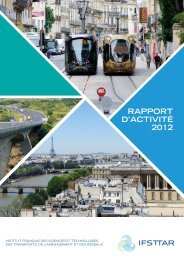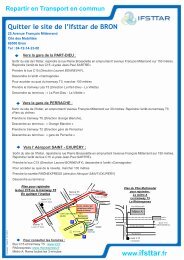french institute of science and technology for transport ... - Ifsttar
french institute of science and technology for transport ... - Ifsttar
french institute of science and technology for transport ... - Ifsttar
Create successful ePaper yourself
Turn your PDF publications into a flip-book with our unique Google optimized e-Paper software.
Research orientation 2_Transport system quality, safety <strong>and</strong> optimization<br />
Communication in<br />
a mobile environment<br />
Progress towards interoperability<br />
Enormous implications <strong>of</strong> road safety.<br />
The ANR PLATA project (Programmable Telematics<br />
On-board Multist<strong>and</strong>ard Radio Plat<strong>for</strong>m) sets out to implement<br />
a new multist<strong>and</strong>ard radio telematics plat<strong>for</strong>m <strong>for</strong> the<br />
automobile sector based on emerging s<strong>of</strong>tware radio technologies.<br />
The flexibility <strong>of</strong> this <strong>technology</strong> makes it possible to use<br />
different communications st<strong>and</strong>ards <strong>for</strong> vehicle/vehicle <strong>and</strong><br />
vehicle/infrastructure communications. The ultimate goal is<br />
to provide Europe-wide interoperability between communication<br />
systems.<br />
In 2011, a PLATA project demonstrator was developed. At the<br />
same time, a large number <strong>of</strong> simulations were per<strong>for</strong>med,<br />
making it possible to evaluate the scaling-up process <strong>and</strong> the<br />
behaviour <strong>of</strong> the system with an increase in the number <strong>of</strong><br />
equipped vehicles. The framework that has been put in place<br />
allows us to carry out realistic simulations <strong>of</strong> vehicle movement.<br />
For this purpose; a simulator - SUMO (Simulation <strong>of</strong> Urban<br />
Mobility) - was interconnected with the trajectory management<br />
functionalities in the OPNET network simulator. The result was<br />
that the trajectory <strong>and</strong> behaviour <strong>of</strong> each individual vehicle<br />
could be identified. The next stage will be to simulate communications<br />
with the OPNET s<strong>of</strong>tware program. During trials<br />
we have simulated the movement <strong>of</strong> several hundred vehicles<br />
with the communications between them.<br />
@ CONTACT<br />
christophe.gransart@ifsttar.fr<br />
55<br />
Simulations on the Satory test track <strong>and</strong> on the<br />
edge <strong>of</strong> the campus <strong>of</strong> Lille 1 University.<br />
Energy <strong>and</strong> planning railway timetables<br />
A new timetabling criterion<br />
The ESTAS research unit is specialized in rail-related<br />
themes <strong>and</strong> its expertise is widely recognized among its<br />
partners (SNCF, RFF) as a result <strong>of</strong> several projects (the<br />
national CIGIFRET project <strong>and</strong> the European ON-TIME<br />
project). In 2009, it began to take energy into account<br />
in its work on traffic management.<br />
with a set <strong>of</strong> distinct possible solutions <strong>and</strong> can then construct<br />
timetables that simultaneously meet passenger dem<strong>and</strong> <strong>and</strong><br />
take account <strong>of</strong> energy consumption.<br />
@ CONTACT<br />
remy.chevrier@ifsttar.fr<br />
The research into optimizing timetable planning which<br />
has got under way since this decision there<strong>for</strong>e now includes<br />
energy as a criterion. Planning <strong>of</strong> this type depends, in particular,<br />
on train movement times allowing <strong>for</strong> disruptions <strong>and</strong><br />
drifting, i.e. when the train moves under its own inertia with its<br />
motor turned <strong>of</strong>f which leads to substantial savings. In 2011,<br />
ESTAS proposed a method that generated a variety <strong>of</strong> driving<br />
strategies using a number <strong>of</strong> speed pr<strong>of</strong>iles based on a trade-<strong>of</strong>f<br />
between journey times <strong>and</strong> energy consumption.<br />
The method involves the multi-goal optimization <strong>of</strong> train movement<br />
<strong>and</strong> is based on evolutionary algorithms <strong>for</strong> the competitive<br />
optimization <strong>of</strong> energy consumption <strong>and</strong> journey times.<br />
For a given optimization task the decision-maker is presented<br />
Speed (m/s)<br />
90<br />
80<br />
70<br />
60<br />
50<br />
40<br />
30<br />
20<br />
10<br />
0<br />
0<br />
20 000<br />
40 000<br />
Benchmark<br />
Alternative solution<br />
60 000<br />
Position (m)<br />
80 000<br />
100 000<br />
120 000<br />
140 000<br />
Example <strong>of</strong> TGV speed pr<strong>of</strong>iles <strong>for</strong> a 135 km journey: the red plot shows<br />
the minimized journey time <strong>and</strong> the green plot shows an alternative strategy<br />
which saves energy while slightly increasing the journey time.<br />
ANNUAL REPORT 2011 ifsttar.fr






![Trajectoire le magazine n°3 - Juillet 2012 [.pdf] - Ifsttar](https://img.yumpu.com/30038493/1/190x253/trajectoire-le-magazine-na3-juillet-2012-pdf-ifsttar.jpg?quality=85)

